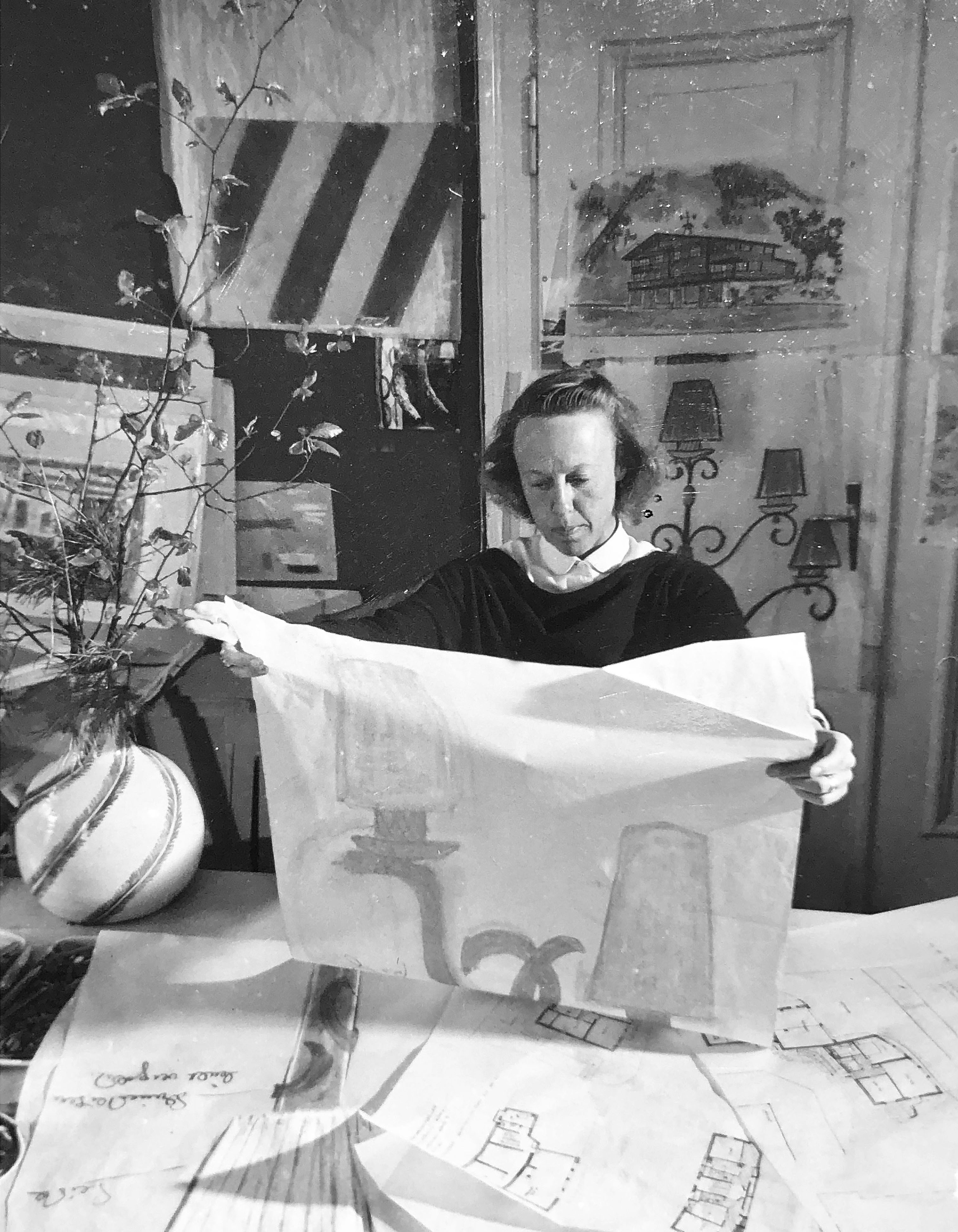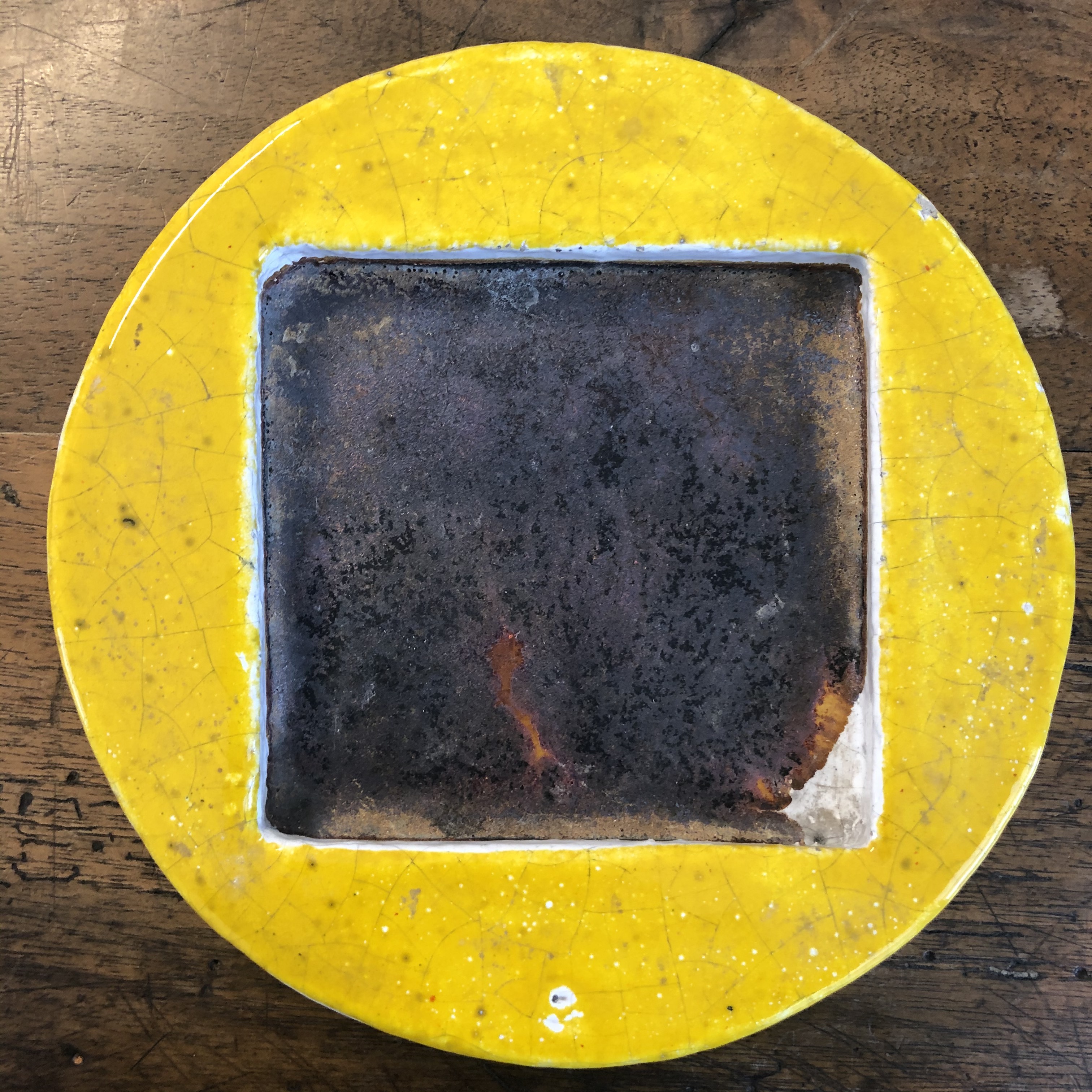I recently had the pleasure of speaking with Andreas Schneider who told me the story of RABIUSLA, a Swiss ceramics studio that was founded by his parents Ursula and Hermann Schneider. The studio thrived over several decades, and gained an enthusiastic following in Europe and the United States. Behind RABIUSLA is the story of a unique family of Swiss artists, led by an exceptional matriarch who invented a new way of making modern ceramic art, while running an architecture studio and raising three young children as a single mother in post World War II Switzerland.
The story begins in 1948. Ursula Schneider and her husband Hermann ran an architecture firm in Zürich Switzerland. They liked to commission custom ceramic tiles for the homes they were building, and decided to bring this work in house. They hired a potter and started their own ceramics studio in a building full of artists on Beethoven Street in the center of Zürich. They named the studio RABIUSLA – Rabi and Usla being the nicknames of their daughters Gabriele and Ursula. Their third child Andreas was to be born that same year.
After her husband’s passing in 1950, Ursula decided to continue the architecture practice. She also began to experiment with the creation of original, low fired ceramics pieces at the RABIUSLA studio. Over a period of several years and through a long series of tests and iterations, she developed a new technique of combining colors and glazing into a single step which allowed her to paint directly onto ceramics and create her own vivid and modern artistic form of expression.
Ursula perfected her new technique and spent three years creating art without attracting any attention or selling any pieces. On the verge of giving up, she was one day visited by a buyer from a ceramics shop on the famous Bahnhofstrasse shopping district in Zürich. After seeing her work he declared that he would like her to pack up her entire collection to have it shown at their store. The show was a success and from then on the studio was busy putting out new pieces and employing multiple potters, painters, and apprentices who implemented Ursula Schneider’s original designs.
RABIUSLA became known for a series of plates, bowls, cups, and ashtrays displaying vibrant, abstract, and sometimes whimsical images. Each image is unique and was only ever painted once, making sure that every piece created by the studio is an original. Ursula Schneider attributed her initial success to a desire to find joy and color during the dark postwar period in Europe. In addition, the 1950s saw a rising interest in original ceramic art thanks to famous artists like Picasso, Miró, and Braque being active in the medium during that time.
Among RABIUSLA pieces, ashtrays deserve a special mention for their unusual production method. Using refractory clay and medieval glazing techniques, the ashtrays have a heavy and raw feel to them, including glazing with intentional, unique cracking patterns. All RABIUSLA pieces are signed on the back in large, simple block letters. Ursula Schneider added her initials US in large blue script to occasional pieces that she felt turned out especially well and close to her artistic vision.
Ursula Schneider cut an unusual and original figure in 1950s and 60s Switzerland. She was a rare single mother who raised her children to be free spirits in a buttoned up society that was steeped in traditional protestant values. Andreas recalls school teachers being perplexed or even hostile when he would take drawing and writing assignments beyond their literal meaning and let his imagination run wild, and he credits his mother with always encouraging and supporting him in doing so. One day a concerned teacher called the Schneider home about an essay that was in his opinion so unusual that he refused to read, much less grade it. He wondered if the mother was aware of her son’s work. She answered “of course, he shares all his ideas with me and we discuss them over our meals”. In another anecdote, Ursula had a fondness for white marble and taking naps after lunch, and decided to commission a large slab of marble as a low dining table surrounded by pillows, so the family could eat like ancient Romans and fall asleep right after their meals. They and their guests ate while lying down for a few years. In addition to running a liberal household, Ursula ran two successful businesses – RABIUSLA making ceramic art and the architecture firm drawing houses, schools, and restaurants (as an aside, Ursula was self-taught as an architect) – she was also a heavy smoker and hired a nanny to help around the house, all of which made for a prolific and modern woman well ahead of her time.
In 1964 the Beethoven Street building that housed RABIUSLA and its fellow artists, including a garden with plots leased out to sculptors, was torn down to make room for a parking lot. Ursula Schneider took the opportunity to purchase a home in the nearby Zürich suburb of Herrliberg and moved her family to the lakefront community. She converted the basement of the house into a new home for the RABIUSLA studio where she continued to gather with multiple employees to produce her original pottery as well as paintings and other artworks. Around the same time her work began to find recognition outside Switzerland. First in the rest of Europe, especially in Scandinavia, and then the United States. Her initial breakthrough in the US came thanks to a buyer from the famous Sacks 5th Avenue department store. He came by for a studio visit and decided to feature RABIUSLA pieces in their New York City flagship store where they found commercial success just like they had in Europe.
Ursula Schneider’s children grew up in their bohemian household and went on to have outstanding lives and careers of their own. The oldest daughter Ursula became a potter and artist herself. She apprenticed in her mother’s studio and worked there for several years before moving to San Francisco to earn a Masters degree and teach at the San Francisco Art Institute. She later moved to the East Coast where she enjoys a vibrant career as a painter and has taught at renowned institutions like The Cooper Union from 1980-1985 and Sarah Lawrence from 1986-2014. Ursula’s second daughter Gabriele studied teaching and sports and became the head coach for the Swiss women’s national gymnastics team. She is also the longstanding vice president of the Association of the Friends of the Zürich James Joyce Foundation, and she owns a large collection of her mother’s and brother’s art. Finally Andreas who was born the same year that RABIUSLA studio was founded, and who spent his childhood growing up among potters and sculptors, ended up becoming a successful graphic designer and illustrator in Switzerland before switching careers to become a fine artist working as a sculptor with materials including ceramics, wood, and metal.
When Ursula Schneider passed in 1978, it was Andreas who took over RABIUSLA and guided it into its second generation. It fell to him to modernize the studio. First, he had to reinvent the colorful and distinctive glazing that his mother had pioneered. Because of new regulations in the 1970s that no longer allowed the use of lead in pottery production, Andreas began a laborious process of creating a new line of lead-free glazes. He eventually succeeded and continued producing RABIUSLA originals, combining his mother’s techniques and processes with new, more modern and linear designs. The studio created a continuous flow of work from the 1950s to the 1990s. Pieces from different areas can be told apart by their signatures. Early pieces produced in Zürich were signed RABIUSLA (sometimes with the addition of ZH to indicate Zürich), after the move to Herrliberg they were signed RABIUSLA HERRLIBERG, and during Andreas’ leadership of the studio they were signed with an underlined RABIUSLA. While Andreas continued to create RABIUSLA work, he also began showing his own work under his name. This mode of dual creation continued until the mid 1990s when he decided to cease production of RABIUSLA pieces and focus all his energy on his personal work. He has built a thriving career that includes popular annual exhibitions of candleholders that he completely reinvented over two decades. His work has been shown in exhibitions and collections throughout Europe, Japan, and the US where he worked in the years 2001 and 2002.
Ursula and Andreas Schneider’s visionary RABIUSLA ceramics can be found in personal collections all over the world and occasionally for sale on art and auction sites, and they are starting to find their way into museum collections as history recognizes their groundbreaking nature. Here are some of Ursula Schneider’s pieces in the Collection of the Museum of Design Zurich.
A personal note: I decided to reach out to Andreas to ask him about his mother because I grew up with RABIUSLA pieces all around our house. My dad was an admirer of the work and I have an early, vivid memory of him taking me to the RABIUSLA studio in Herrliberg when I was a little boy in the 1970s. It was the first time I met a working artist and visited an artist’s studio and it left a deep impression. Thank you Andreas for sharing the RABIUSLA story and images of your mom and of the work.









